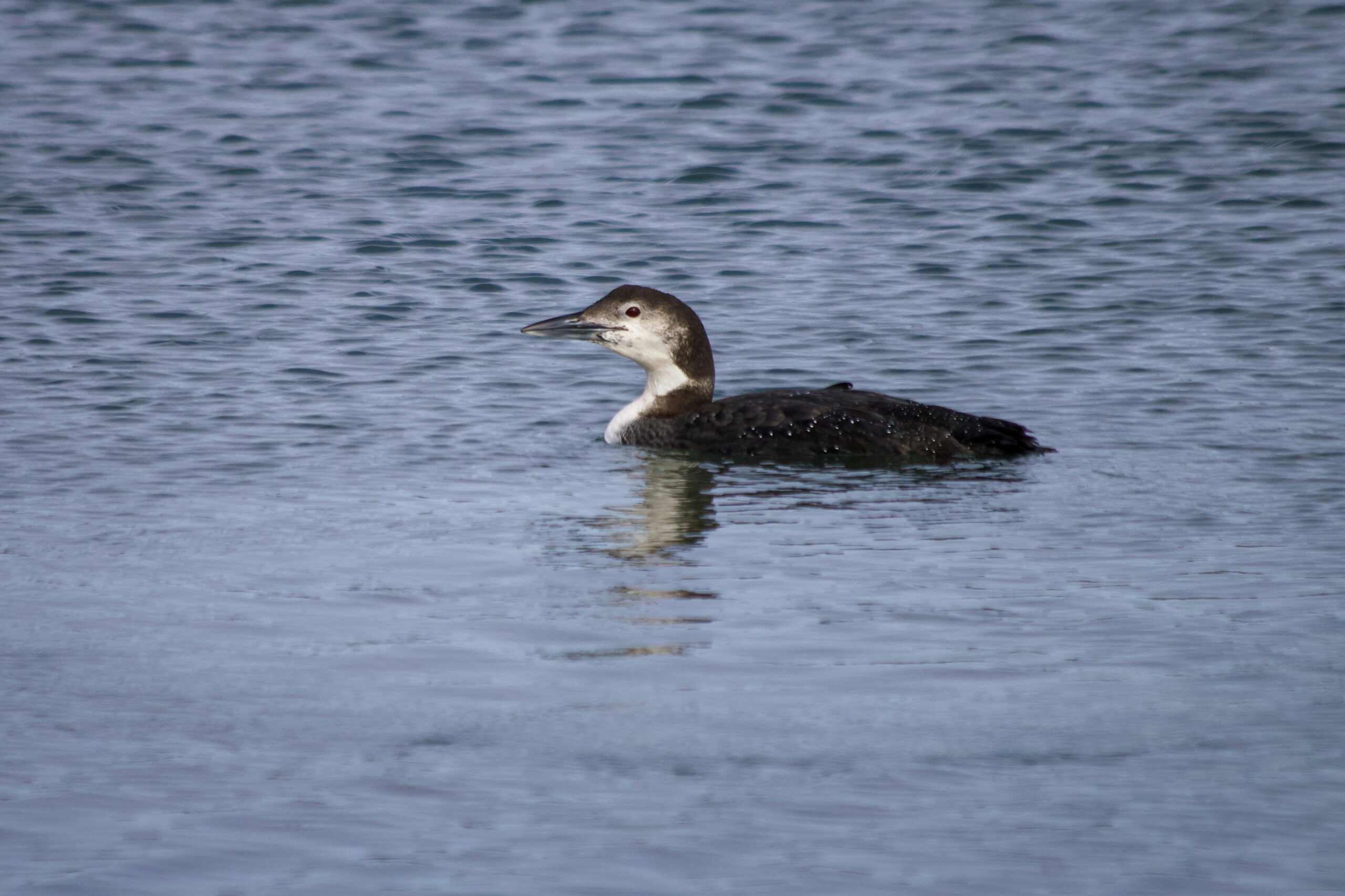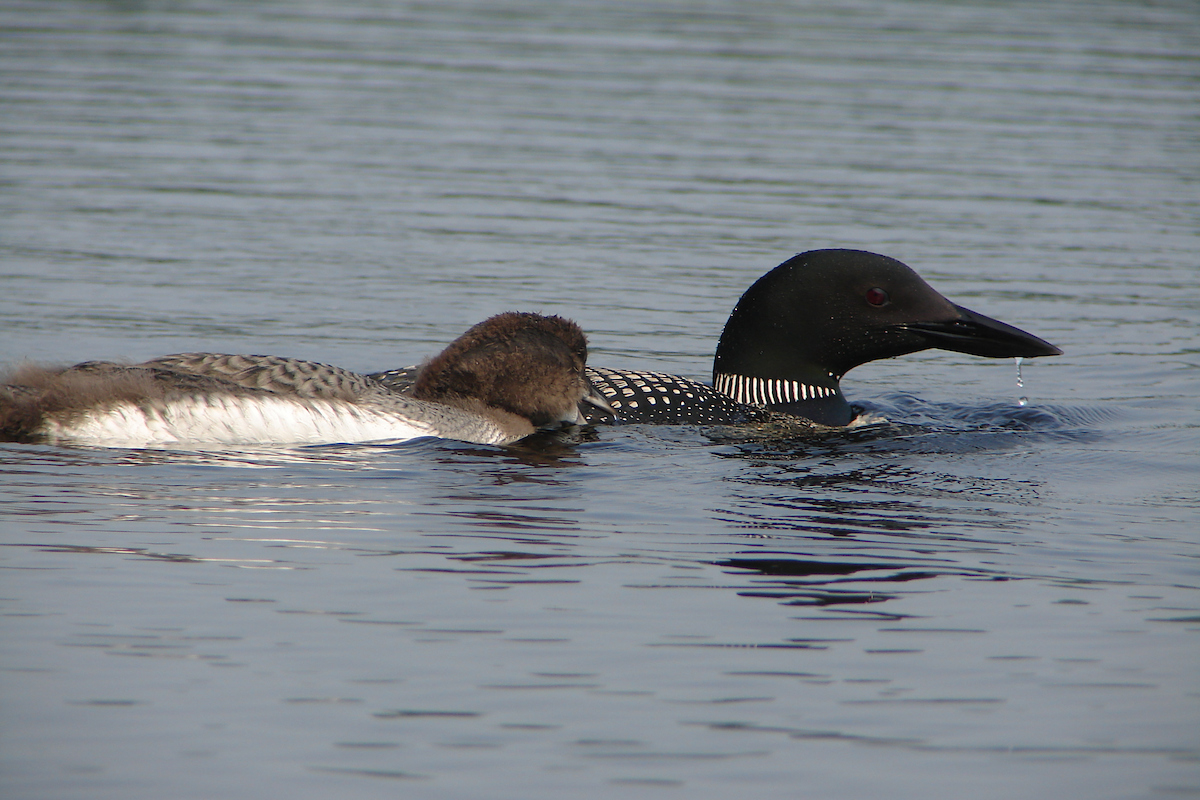
To say we’ve had crazy weather this winter in Maine would be an understatement. Many lakes remained unfrozen as we headed into the winter, then finally iced over, only to unthaw in a warm spell, and freeze again with the next cold snap. These conditions have made it tricky for all of us planning on ice fishing or skating. But what have these unusual weather and lake patterns meant for Maine’s Common Loons?
Normally, loons take flight from their breeding lakes long before the ice closes in and fly to overwintering areas off the Atlantic coast where the salty, tide-driven waters remain unfrozen. In loon families, one parent will often leave the lake first, while the second parent continues to diligently care for their chicks until they are at least twelve weeks of age and ready to fly and forage on their own. At this point, the second parent often leaves the chicks and rafts up with other socializing adults before heading to the ocean. (This is when we sometimes get the joy of seeing dozens of loons rafting up together in the fall). Chicks are normally the last to leave.
However, every year some loons stay too long on the lake where they hatched or spent the breeding season, and they get trapped as the ice closes in, leaving too little open water for takeoff. Quite often if these iced-in loons are recovered and evaluated, some type of underlying issue is discovered that likely prevented them from flying off their lake—an injury, infection, illness, developmental issue, lead poisoning, entanglement in fishing line, etc.
This year though it hasn’t been the usual smattering of loons that have stayed on Maine lakes into the winter. Loon biologists and wildlife rehabilitators throughout the state have received a flood of calls and emails reporting iced-in loons through December and into January. Why are so many sticking around? For some the cause was obvious. In one dramatic case, a loon was iced-in, attacked by an eagle, rescued, and then later died of its injuries. It turned out that the loon had a bullet embedded in its body and fishing hook in its gut when it was necropsied (a necropsy is the equivalent of an autopsy). No wonder this loon couldn’t take flight and became a target for predators. Too many others were found to have had lead poisoning from ingesting lead tackle. Some had injuries caused by loon competitors, predators, or boats.
However, there wasn’t a proverbial smoking gun or an obvious cause for a number that were lake bound this year. Frequently when there’s a warmer fall, some loons just seem to get lulled into staying on their lake too long by the warmer water temperatures, late freezing, and continued access to prey. Some stay so long that they begin the complete molt that usually occurs on ocean wintering grounds while they are still on freshwater. Because this molt leaves them flightless for a month, they can get stuck, unable to take flight if there’s a cold snap and ice starts forming. So it’s likely that the unusual weather contributed to the number of loons getting iced-in this year or starting migration much later than normal and then stopping over to rest on lakes that were in the process of freezing over.
A number of the calls we’ve received are about loons being sighted on a lake where all of the resident loons had left earlier in the season. The callers have expressed worry that the loons are returning to their breeding grounds too early.


Whereas loons that return to breed in the spring come back in their black and white breeding plumage, those being reported on lakes this winter are outfitted in the more drab winter adult plumage (often mistaken for juvenile loons which have similar coloring and patterning, but more pronounced scalloping on the back). As such, they are likely birds in late migration from a lake farther away stopping over on available open water while en route to the coast. The hope is that these loons will continue on their way before the ice closes in so much that they can’t take flight.
So what should you do if you see a loon that is trapped in the ice or enclosed in a small area of open water? State game wardens can sometimes help determine if a loon is in need of rescue and potentially connect you with rescuers, but they do not perform wildlife ice rescues.The Biodiversity Research Institute is currently the only organization that conducts ice rescues statewide and their biologists have been busy rescuing as many iced-in loons as possible. Some fire departments and local entities are also gaining experience and training in ice rescues and may be able to help. But it’s tricky and dangerous business and many loons can’t be rescued safely. Ice rescues will generally only be attempted if the loon is enclosed in a very small area, it is relatively close to shore, the ice is thick enough to support the weight of rescuers and equipment, and there is rescuer capacity and availability.
If the trend does continue, and we continue to see more and more loons iced-in, we’ll need to make some difficult decisions about when and where loons should be rescued and how much funding and staff resources to devote. Are there times we should let nature take its course? Do we do all we can to aid these loons and seek to increase capacity for loon rescues statewide? Do we take a more nuanced approach and try to prioritize rescues, such as where regional loon populations are down? This is one of the many examples where changing climate patterns are beginning to challenge our current approaches to resource management.
Where to report iced-in loons:
Biodiversity Research Institute, (207) 839-7600, bri@briwildlife.org
Maine State Warden Dispatch at 1-800-452-4664 or the Warden Service at (207) 287-8000
The Wildlife Assistance Hotline, (207) 361-1400, coordinated by the Center for Wildlife
